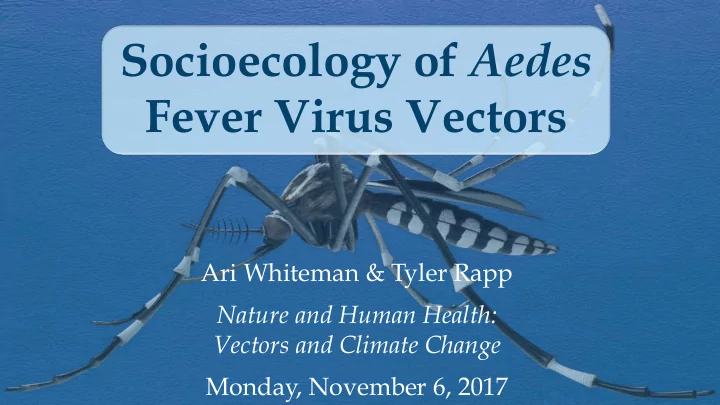

Socioecology of Aedes Fever Virus Vectors Ari Whiteman & Tyler Rapp Nature and Human Health: Vectors and Climate Change Monday, November 6, 2017
Background Mosquito-borne illnesses are increasing as a result of § climate change, urbanization, and globalization Charlotte has moderate to high potential for viral § activity as a result of these three factors Figure 1. Average temperature across the US Figure 2. Airport routes from Charlotte Douglas International Airport
Objectives Determine the fine-scale spatiotemporal hotspots of 1) Aedes mosquito activity in Mecklenburg County Determine the effect of a socioeconomic variation on 2) regional urban mosquito abundance Model habitat suitability that can be used to direct vector 3) surveillance and control efforts Figure 3. Examples of mosquito-breeding areas/containers
Socioeconomic Status & Mosquito Abundance? Previous studies 1 have shown that: § There is more urban decay in low-income areas § Urban decay is linked with more unused § containers à accumulate water when it rains à prime breeding spots There are less mosquito-borne illnesses in high- § income regions Hypothesis: § In low-income residential areas, the abundance § of mosquitoes will be higher This study is unique in its selection of sites in § regards to strictly residential areas with similar population density and a large geographical Figure 4. Examples of mosquito- range breeding containers 1 Becker, Leisnham, LaDeau, 2014; LaDeau, et al., 2013; Dowling, et al., 2013
Methods: Site Selection Optimization procedure to select § the census tracts Varying socioeconomic, § infrastructure-based, and environmental variables One trap was placed in the § center of each tract Two were placed in the nine § tracts in the upper quartile of population density giving 90 traps total Figure 5. Residential units density map
Methods: Traps Gravid Aedes Traps § Attract gravid (pregnant) § container-breeding mosquitoes by: Hay-infused water § Black color (more heat) § Figure 6. Gravid Aedes Trap
Methods: Sampling Scheme Traps were checked § once a week from May 26 - August 21 Each mosquito § specimen was identified to species and counted
Methods: Data Analysis Analyzing numerous § socioeconomic, environmental, and land-cover based variables on the amount of mosquitoes caught at each site Figure 7. Charlotte-Mecklenburg Rainfall Network map
Results Over 4,000 mosquitoes were caught during the study § No Aedes aegypti were found § 86% caught were Aedes albopictus § 600 Total Samples Collected 500 400 Figure 8. Mosquito 300 samples collected 200 over a 12 week period (May 26 – 100 August 21) 0 May June July August Weeks
Species Distribution 4.82% 0.87% 0.81% 13.79% 86.19% 5.72% 0.87% 0.35% 0.35% A. albopictus A. triseriatus A. vexans A. japonicus A. spp C. restuans C. pipiens C. spp Figure 9. Distribution of mosquito species caught over the entire study
Preliminary Models Figure 10. Map of mean samples caught over a 12 week period (May 26 – August 21)
Preliminary Models Regression of mean samples caught by SES percentile (R ² = 0.065, p = 0.001, Coef. = -5.51) 15 Mean Samples Caught 10 Per Site Per Week 5 0 0 0.1 0.2 0.3 0.4 0.5 0.6 0.7 0.8 0.9 1 -5 -10 SES Percentile Model(Mean) Conf. interval (Obs 95%) Figure 11. Regression of mean samples caught by SES percentile
Considerations Sampling Design: Innovative – but § not yet validated Higher margin of § error due to lower density covered per “region” Figure 12. Map of Mecklenburg County
Conclusion: Key Takeaways Aedes albopictus was nearly § the sole mosquito caught over the course of the 12- week study Varying geographic densities § of mosquitoes are apparent throughout the county While currently weak, there § is a statistically significant correlation between socioeconomic status and mosquito abundance
Conclusion: Next Steps Primary investigator is § currently completing a comparative study in Panama City, Panama Further analyses (blood meal § analysis, investigating more variables, etc.) upon his return Plan to release a full, § comprehensive report to the Mecklenburg County Health Department by the end of spring
Acknowledgments I would like to thank: Ari Whiteman, § Primary Investigator Collection Volunteers § Mecklenburg County § Health Department Academy for Population § Health Innovation (APHI) Smithsonian Institution § The Levine Scholars § Program at UNC Charlotte
EXTRA SLIDES* *NOT in actual presentation – only for supplement
Aedes Genus Aedes albopictus : vector of dengue, yellow fever, and possibly Zika § in the wild (more diseases under lab conditions) Aedes vexans : can transmit Eastern equine encephalitis (EEE), § Western equine encephalitis (WEE), Saint Louis encephalitis (SLE), West Nile virus, and dog heartworm Aedes japonicus : can transmit West Nile virus § Aedes triseriatus : can transmit LaCrosse strain of California § encephalitis and more (such as yellow fever) under lab conditions
Culex Genus Culex pipiens : has been found naturally infected with Sindbis § virus, WNV in Israel and Egypt, etc. Culex restuans : vector of SLE and WNV §
Variables Used in Optimization Procedure Variables § Home sale prices § Percent of residents with a bachelor’s degree § Household income § Employment rate § Tree canopy cover § Violent crime rate § Foreclosure rate § Percent Hispanic and percent black § Percent of land cover vacant § Proximity to a park § All variables were independent – not correlated §
Additional Variables Being Studied Later Environmental Variables (about 100m around each trap): § Type of land surrounding (satellite imagery) § Amount of vegetation around § Property occupancy § Amount of trash present § SES: § Income § Housing values (real estate data) § Both environmental variables and SES variables will be in relation § to the abundance of mosquitoes caught at each site
Recommend
More recommend